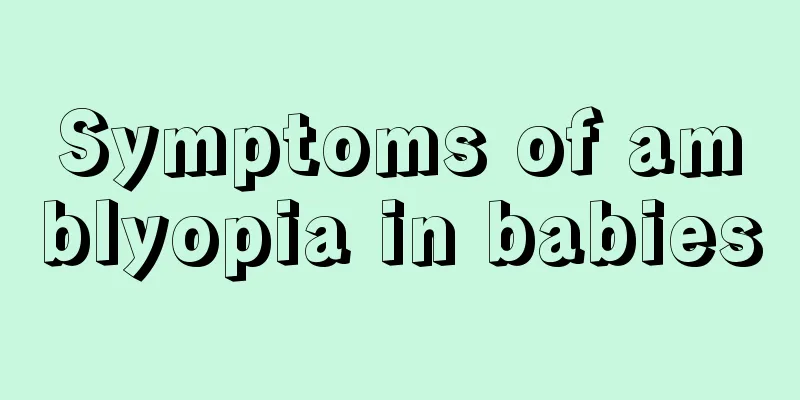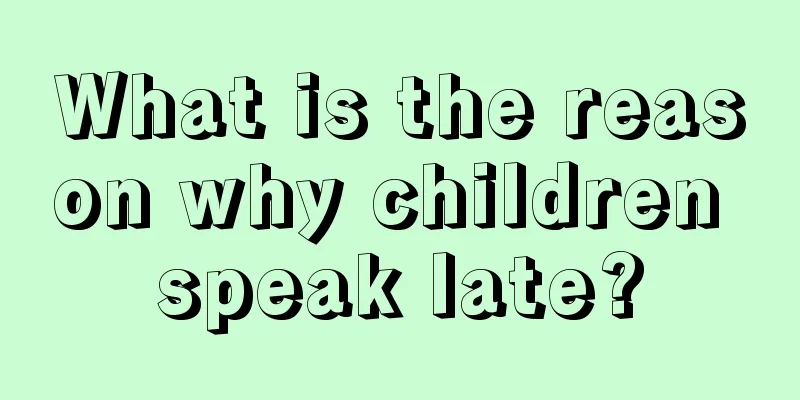Symptoms of amblyopia in babies

|
The health of a baby will largely affect the happiness of a family. For young parents, welcoming a new life for the first time is an exciting and cautious thing. In addition to paying attention to the daily life of the child, parents should also pay attention to the child's physical health. Amblyopia requires special attention from parents. The following article will introduce the manifestations of amblyopia in babies! The biggest harm of amblyopia is that the child not only has low vision in both eyes or one eye, but also lacks perfect binocular vision function and fine stereoscopic vision. The harm of amblyopia is far greater than that of myopia. This is because children with simple myopia can see things blurred at a distance but clearly at close range. Their visual cells and nerves can still be stimulated by external objects and will not decline. However, it is different with amblyopia. Because their visual cells and nerves cannot receive accurate stimulation from external objects for a long time, they decline. If it is not prevented and treated in time, vision will be permanently impaired. Therefore, amblyopia will affect the life, study and work of patients for a lifetime. In their eyes, the stereoscopic vision is blurred, and they cannot accurately judge the direction and distance of objects. The main manifestations of amblyopia in babies are as follows: 1. Fear of light. Children with amblyopia are usually afraid of light and become irritated when seeing light. 2. Nystagmus. Abnormal eye twitching 3. Strabismus. One eye turns inward or outward occasionally or frequently 4. Bad posture. Every time you need to use your eyes, your head will be tilted or deflected in a certain direction, or your chin will be lowered or raised in other bad postures. This is because you can’t see clearly and you unconsciously change your body position to find a clear angle. 5. Poor eye-hand coordination. Poor eye-hand coordination, prone to collisions or falls. 6. The words will appear opposite or upside down. Often read the wrong line when reading, or read and write words in reverse or upside down. 7. Squinting when looking at things. I can't see things clearly and I squint unconsciously. 8. Looking at things from too close. When reading, writing, or looking at something far away, I often look at it from a close distance because I can't see it clearly. 9. Abnormal eye appearance. Other signs of amblyopia include droopy eyelids, white spots behind the eyes, different eye sizes, and different pupil sizes or shapes. If you experience the above symptoms of amblyopia, please go to an ophthalmologist for examination and treatment in time. The earlier amblyopia is treated, the better. The more timely the treatment, the greater the possibility of visual function recovery. |
<<: What causes black spots on baby's face?
>>: How does amblyopia develop in children?
Recommend
How much milk is best for a one and a half year old baby to drink every day?
We all know that drinking milk is something that ...
7 ways to avoid educating girls
1. Teach her to be polite and quiet There's a...
What are the causes of indigestion in babies?
The younger the child, the worse his physical fit...
High-salt foods damage brain cells. Children should eat less of these seven types of food.
The healthy growth of the baby is the wish of eve...
What to do if your two-month-old baby has a stuffy nose but no runny nose
If a two-month-old baby has a stuffy nose but no ...
How old can babies eat mashed potatoes?
Potatoes, commonly known as potatoes, are a nutri...
Will the baby have diarrhea if the weather is too hot?
In July and August, the weather is very hot, and ...
What causes redness and swelling around the anus in children?
Perianal abscess is an emergency in the anorectal...
What should I do if my baby has very loose stools?
It is normal for babies to have loose stools when...
Why are children not concentrating on eating?
Many children, especially those aged 3 to 7, ofte...
What can you eat to make your fetus’ legs grow faster?
The healthy development of the fetus is an issue ...
Redness around baby's anus
Babies often have red buttocks because their skin...
What bed is good for newborns?
When welcoming a new life, many families will pre...
What material is better for baby crawling mat?
When choosing a baby crawling mat, you will alway...
What to do if your child has a cough after eating cold food
In summer, everyone likes to eat some cold food. ...









